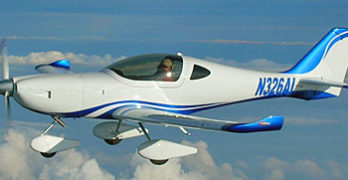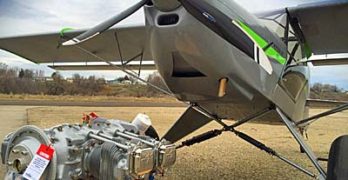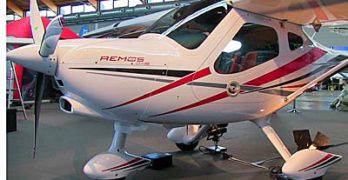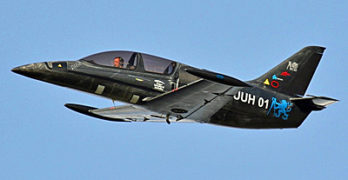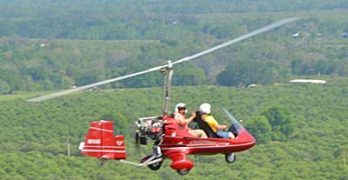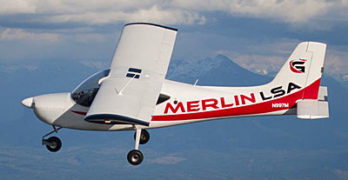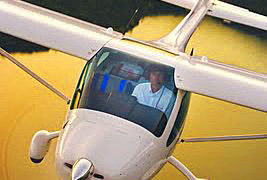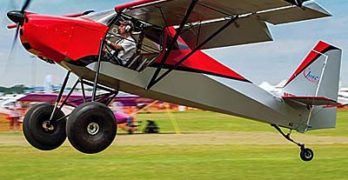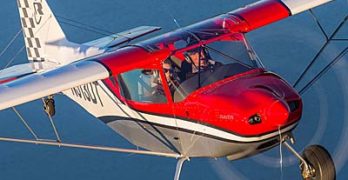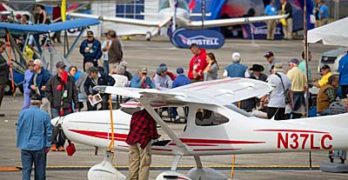Recently, aviation titles chronicled the rollout of Sun Flyer’s prototype electric powered airplane. To careful observers, the aircraft might appear somewhat familiar. Good eyes, folks. The prototype was built for Aero Electric Aircraft Corporation by Arion Aircraft. The beautiful sweeping lines of the Sun Flyer are nearly identical to the Lightning LS-1.
The one notable difference — and in fact this is the whole story — is the electric motor up front allowing Sun Flyer to look even a bit more streamlined than the dashing outline of Lightning. This is a first article aircraft as photos don’t yet show any solar cells on the wings, as promised by Aero Electric.
Regardless of how AEAC develops Sun Flyer down the line, it was wonderful to see them linking up with Arion Aircraft whose LSA and kit models have been admired for their gracefully smooth shape for some years.
Search Results for : Flight Design
Not finding exactly what you expected? Try our advanced search option.
Select a manufacturer to go straight to all our content about that manufacturer.
Select an aircraft model to go straight to all our content about that model.
Invasion of the Titan; More LSA Go Big Power
In my many years in aviation, I’ve learned this about light aviation pilots: If 80-horsepower is good, then 100-horsepower is better, and even more is best of all. It explains why interest was so high when Rotax announced their new 915iS that will provide 135 horsepower. It also illustrates why the 180 horses of the Titan X-340 is succeeding in the Light-Sport Industry.
Interest from LSA producers started with CubCrafters adopting the engine several years ago. When that company’s boss, Jim Richmond, held a press conference at Sun ‘n Fun, the reception was somewhat cool. Of ten persons in the audience, only four of us were journalists. The other six (yes, 6!) people were from FAA. No wonder, perhaps, as ASTM standards at the time brought questions to mind regarding the use of such a powerful engine. Those standards have since been modified somewhat.
Indeed, the western producer instructed users that the engine could only be used at full power for takeoff or climbing, but otherwise had to be set to lower power.
Remos is Back and Scores at Aero 2016
Think back far enough in the still-fairly-new LSA sector and you should recall a time when one brand made some major impact on all of personal aviation. The company was Remos and their U.S. team amped up promotional activity to the level of full page ads in most of the biggest aviation magazines in aviation. By my casual estimate, Remos was spending north of $35,000 per month on splashy advertisements.
Remos also did an airplane giveaway with AOPA; the company was a seemingly unstoppable juggernaut. Prudent or not, you had to admire that the company pulled out the stops in an effort to become the main LSA brand. Such a no-holds-barred approach has worked for products in other industries. However…
Then the door of opportunity slammed shut. It was not that the advertising didn’t work. Certainly it did make the brand well recognized. However, by 2009 the global economy was in a tailspin.
You Wanna Be a Jet Pilot? Check out UL-39
When they introduced Light-Sport Aircraft FAA prohibited use of a jet engine. Looking at the photos nearby you can see that this airplane cannot pass must as a LSA. Or, wait! That’s no jet. It just pretended to be one at Aero Friedrichshafen 2016.
At my home airport (Spruce Creek Fly-in), I regularly see one or another full-size L-39 in various stages of being prepared for a new American owner. I was told that about 200 of these ex-Czech military jets are operating in the U.S. They are handsome, sleek, and fast-like-a-jet. Contrarily, the UL-39 is not as fast but neither should its cost of upkeep be anything close to a military jet.
We’re getting a bit ahead of ourselves. The UL-39 on display was a wonderful proof-of-concept aircraft that managed to engage nearly a generation of students in aeronautical engineering disciplines at the Czech Technical University in Prague.
Gyronauts … Pre-Sun ‘n Fun Wing Fling
Welcome to a guest editorial by Roy Beisswenger, publisher of Powered Sport Flying magazine and a close follower of the gyroplane scene. —DJ
Bensen Days in Wauchula, Florida is our annual pre-game party leading up to Sun ‘n Fun. The Sunstate Wing & Rotorcraft Club schedules this annual soiree to coincide with Sun ‘n Fun. By holding their fly-in one week before SnF, they make it possible for vendors and participants to get a two-for-one deal. One trip south gets them two great sport aviation events. The scheduling certainly makes it possible for Vickie and me to participate.
Gyroplane organizations are not the huge organizations that we see sponsoring major events like Sun ‘n Fun and AirVenture. There is no paid staff and no big budget. The volunteers that put it together collect fees and donations to cover their expenses and build up the kitty for the next event.
Two More SLSA Makes 140!
Predictions of a great thinning of the herd… of a consolidation of LSA producers to a handful of leaders never came to pass. No wonder, when the new Special LSA acceptances keep piling up.
What I find quite fascinating is that the four newest SLSA were Made-in-American aircraft or seven of the last ten. The Yankees are coming on stronger after the Europeans owned the market for the first few years.
I have new SLSA airplane market share numbers for 2015 thanks to hours of work by my friend and LAMA associate, Jan Fridrich. With Sun ‘n Fun and Aero approaching I have simply been short of time to give such important info the attention it deserves. Yet, as soon as possible…
Meanwhile I am pleased to announce the latest SLSA. Welcome to Glasair’s Merlin LSA that we reported in this video with company president Nigel Mott.
AOPA crack reporter, Al Marsh reported Merlin LSA is priced at $149,950.
Remos Roars Back with GXiS; Aero 2016 Debut
Article updated March 9, 2016 — Skybound Aviation in Cape Girardeau, Missouri has been appointed the “exclusive resource” for Remos G3 and GX parts in the USA. The company operated by Glenn “Mac” McCallister and Bev Cleair is open for service 6.5 days a week (not Sunday mornings) and is also a dealer for Remos. Contact them at 573-833-0426 or email Mac.
In our 2014 report, you read that a well-known German supplier of Light-Sport Aircraft, Remos, fell from their high perch. The company became known to nearly all Americans when the U.S. importer, closely allied with the German producer, ran a series of full page ads in the USA’s biggest aviation magazines. It brought wide awareness but cost the company dearly. As their timing coincided with the global economic downturn, Remos stumbled badly and was forced to go through reorganization.
As reported, a new investor stepped up during the process and Remos has persevered.
SuperSTOL Gets Superpower with Titan’s 180 Horses
Article updated 2/16/16 — In a freshly-edited video (see at end), Just Aircraft key fellows Gary Schmidt and Troy Townsend provide extra comments and we add additional footage of SuperSTOL climbing strongly with the Titan.
Even before Continental Motors took over the former ECi, that company’s Titan engine has been turning heads. CubCrafters was first to this party, installing the 180-horsepower engine on their Cubalike LSA, demonstrating very short takeoff rolls before climbing steeply. Since then, quite a few other producers have embraced the potent engine and more are coming. This development is sufficiently interesting that I am at work on an article about three “divisions” of powerplants for LSA, light kits, and ultralights.
However, all other users of the Titan are unlike Just Aircraft’s SuperSTOL, which itself has turned many a head at airshow demonstrations. SuperSTOL was able to rivet pilots’ attention when it performed with the 100-horsepower Rotax 912, so imagine the neck-snapping twists that will occur when people get a chance to see how this moveable-slats airplane on tall, telescoping gear performs with 180 horses doing the pulling.
Newest Special LSA Is … Rans’ S-20 Raven
The world of Light-Sport Aircraft has matured in the sense that we no longer have an airplane or two or three every month being added to the SLSA List. That may sound like a “industry slowdown” to some folks but I don’t believe that’s an accurate assessment.
A more realistic view is that the feverish rush days of 2004-2006 are over. That means not as many new SLSA are being offered though the truth is many of those 137 aircraft never found a substantial market.
Indeed, our market share list of SLSA airplanes shows the top 20 brands represent better than 85% of all sales. Regretfully, our ranking shows only airplanes as we are unable to pull good data from FAA’s database for motorgliders, weight shift trikes, powered parachutes, and other “alternative” aircraft.
All that said, I am pleased to announce one of our most solid companies — Rans — continues to introduce new airplanes like their S-20 Raven and to qualify them to be accepted by FAA as a fully-manufactured Special Light-Sport Aircraft.
Weather Threat Derails Sebring for One Day
SEBRING EXPO 2016 — Opening day Wednesday started out unseasonably cool … but true to form — Florida is called the Sunshine State for good reason — the sun warmed the day nicely. Several vendors told me they thought it was the best opening day yet for the Sebring Expo.
Thursday was even more pleasant. A few of us showed sunburned faces by the end of the day, but in all, it was a second good day of the event in its 12th year (not coincidentally the same number of years for which we’ve had Sport Pilot / Light-Sport Aircraft). Several vendors reported many qualified customers and many attendees to whom I spoke seemed pleased with the depth of exhibitors and products to examine. Shows like Sebring and the Midwest LSA Expo offer more opportunity for demo flights and longer conversations with vendors who are often besieged with dense crowds at AirVenture or Sun ‘n Fun.
- « Previous Page
- 1
- …
- 78
- 79
- 80
- 81
- 82
- …
- 147
- Next Page »


